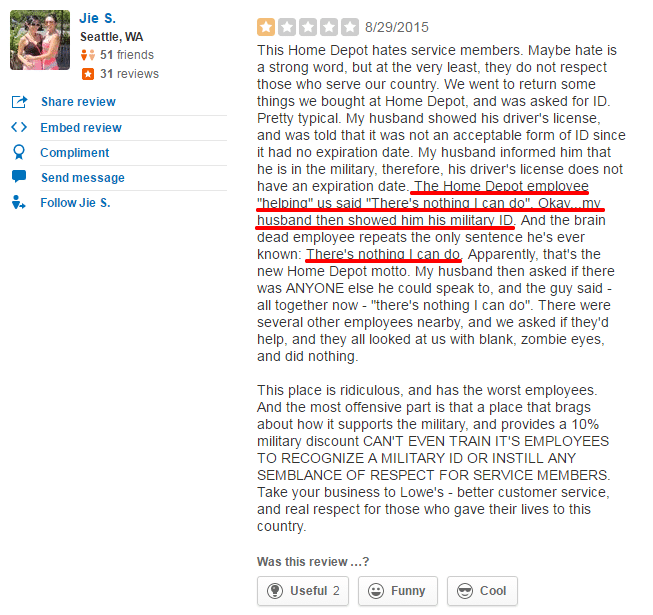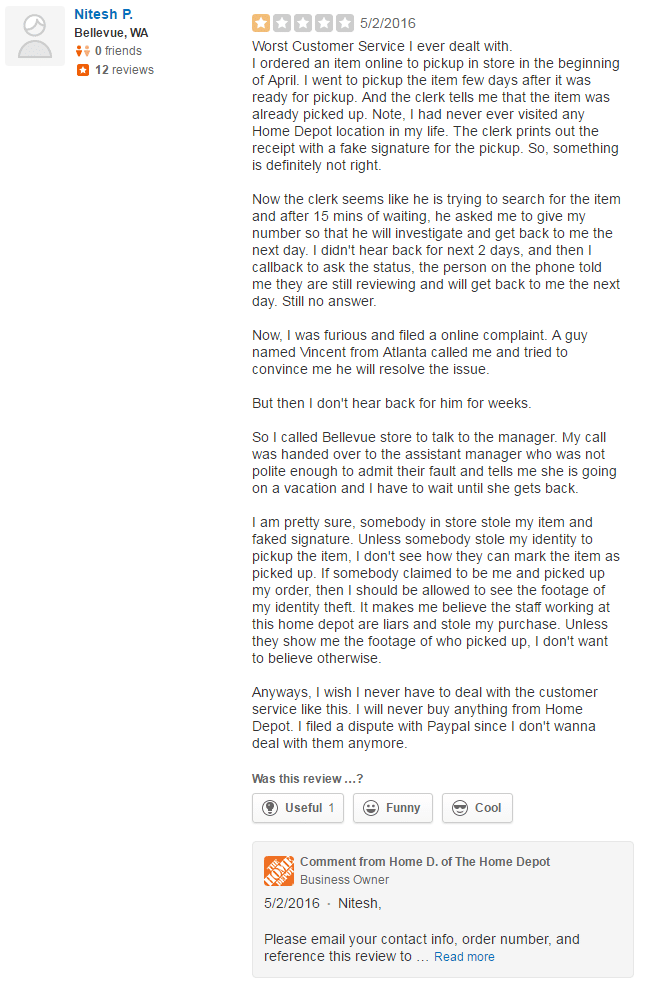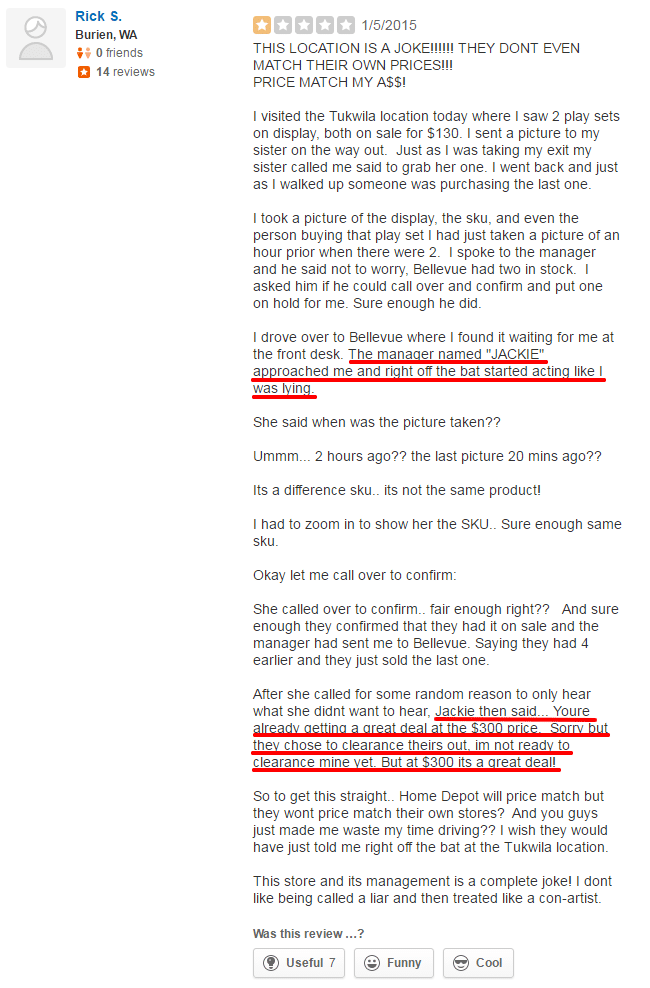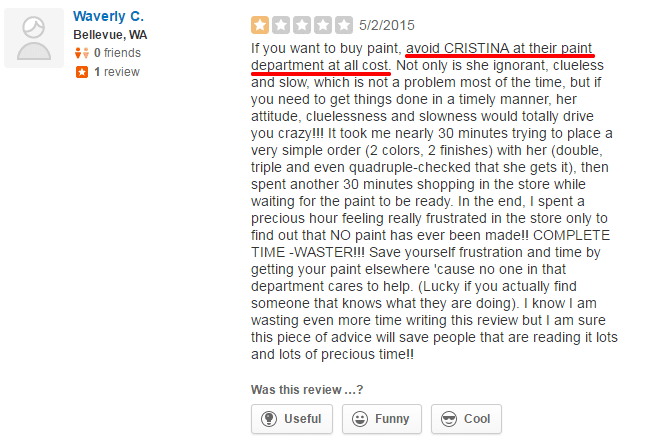Pick one, quick.
Your company has just received a negative review. One where the customer says some pretty terrible things about one of your employees.
Your employee is an all-star as far as you’re concerned. On the other hand, your customer may be right. Both your employees and customers expect you to pick a side.
Get it wrong and you may do lasting damage to your business, customer and employee relationships.
Customer vs. Employee: Whose side do you take?
Side with customers and you risk creating anger and bitterness in the ranks. Team morale drops as employees start to believe you don’t care about them.
On the other hand…
Side with employees in your rebuttal and you make a bad situation worse. You infuriate your customer and you send a message to prospective customers that you simply won’t take care of them.
It’s a no win situation.
If you’re inexperienced you do the “smart” thing
You run.
You ignore, evade or hide from the conversation. You do everything you can to avoid facing the problem. On the surface that seems like cowardice.
But, it’s a smart move.
The last thing you want is to end up in a toxic altercation with your employee and your customer. That would be terrible for all kinds of reasons. Saying nothing is easier when you don’t know what to say or how to say it.
It’s completely understandable.
But, in many cases, it’s also the wrong move. Because your silence communicates a message to your employees and customers – a message you don’t get to control.
Silence sends messages like…
- “They don’t care about their customers”
- “I can’t trust these guys”
- “They’ll hurt me”
- “They’re ____ and that’s bad”
Your silence is a breeding ground for bitterness and resentment – on both sides. It seems like the smart thing but it actually encourages employees and customers to fill-in-the-blanks.
A better option?
Make a stupid decision. Start a fight instead
When people hear the word “fight” their minds tend to go to dark and unpleasant places. We think about abuse, fear, dysfunction, toxicity.
That’s the problem.
When we fight, we focus our attention on a “who” which inevitably leads to disaster. What if, instead of fighting a who, you decided to fight a what?
Focusing on the “what” creates freedom.
Your employees want you to take their side. The customer expects you to take theirs. They’re both focused on a “who.”
Which “what” do you fight first?
It isn’t just about fighting a “what” it’s about fighting the right “what.”
The right “what?”
Let’s look at the Home Depot in Bellevue, WA for an example.
1. Procedures. The wrong procedures create customer/employee conflicts.

Poor procedures like these create conflict, putting customers and employees at odds with each other. So, how do you fix this? As management, you apologize, taking responsibility for the poor procedure that lead to this conflict. Then, you make it right.
2. Structure. Your offer, product or service structured in a way that creates aggression or frustration.

See the recurring theme? Customers want help with a particular problem (e.g. customer service, fulfillment, etc.) but they’re not hearing back/getting help from staff in a timely fashion. It would be easy to automatically assume these employees are lazy, poorly trained, etc. What if they’re overwhelmed?
So, how do you fix this? Start by determining whether employees are overworked or not. If there aren’t enough employees to cover busy periods, customers won’t be happy. Look for structural problems that create conflict (e.g. understaffed, overworked, undertrained). Apologize to customers, address the problem, then work to restore the relationship.
3. Mismatch. Customers want A. You’re offering B. Customers believe you’re offering A.

Home Depot agreed to price match. This customer wanted to price match clearance items, something Jackie, the store manager refused to do. Naturally, this customer was upset.
Their policy didn’t explicitly reject clearance items. What’s worse, this customer didn’t think Jackie believed her.
So, how do you fix this? If you’re part of management, you give customers the benefit of the doubt. You show them a three step process.
1. Confirm what they believe they deserve
2. Give them concrete proof of what you’re offering
3. Then, give them the benefit of the doubt.
Expectations. What customer expect vs. what they get creates frustration, conflict and pain.

These customer reviews show customers arrive at the store with specific expectations.
1. Expertise. Customers expect staff and sales teams to be knowledgeable, fast and efficient.
2. Handholding. Customers at this location expect to be waited on. They want staff to be understanding and focused on their needs – even if that means dealing with noisy kids.
3. Customer service. They want helpful customer service, they want to be taken care of.
See the common theme with each of these?
It’s a willingness to help.
Customers want your team to be friendly, to give them what they need. They’re looking for acceptance and compassion. When it’s appropriate they want you to bend the rules a bit. Employees want the same things.
Procedures, structure, mismatch and expectations – these function as barricades. So, you do the wise thing.
You take responsibility.
When a customer calls an employee out, you take responsibility. Sometimes that means you take the blame. Most of the time that means you make things right.
Taking care of customers is a disaster…
… If you’re dealing with trolls, ragers or toxic people in general, it’s a terrible idea. Monitor these customers yes, but don’t engage with them.
They don’t want resolution.
Trolls, ragers and toxic people aren’t looking for a compromise. They’re not looking for facts and they’re definitely not looking to negotiate. They’re looking to inflict pain. Their motives are selfish and they’re closed off to anything you have to say.
In fact, there’s really only two customers you can help.
1. The misguided customer. These customers are confused, they’re relying on incorrect or untrue information. So you respond in kind. You share the facts, then when they’re open, you restore the relationship.
2. The unhappy customer. This customer has had a genuinely negative experience. So you do what you can to fix the situation, offer a reasonable solution and restore the relationship.
What about negative comments towards that employee?
Am I saying you simply ignore negative comments to employees? Not at all. I’m saying that you respond accordingly. There are three basic ways to handle abuse.
You…
1. Spear. This is the direct approach. You call customers on their bad behavior, you address their poor attitude or inappropriate comments directly. This is a crucial conversation when it’s done well; name calling, bullying or controlling behavior when it’s done poorly.
2. Parry. You redirect the conversation to the issues that matter. If they’re focused on an area that isn’t constructive, you redirect the conversation to the issues that matter most. A good response to: “Selena is the worst!” could be, “I’m so sorry you’ve had a terrible experience. What can we do to make things right?” This de-escalates the situation and avoids the insult entirely.
3. Evade. Ignoring insults, using silence, avoiding specific customers – these are all evasion methods. Trolls, ragers and sadists are best handled with evasion. The more you engage with them, the more aggressive they become.
Here’s the thing about customer interactions. There’s no hard and fast rule. You’ll need to look at the variables involved and choose the right strategy.
It may be a good idea to parry a customer’s insult if an employee is out of line. You may want to avoid a toxic temper tantrum. Maybe it’s a good idea to spear customers, taking the direct approach to conflict.
You’ll need to decide in the moment.
You’ll also need to decide how to handle poor employees
Which employees are repeat offenders or trouble makers? How do you address repeat offenders? What is a repeat offender? If you’re dealing with a few bad apples it’s best to act quickly and decisively.
But it all depends on you.
What’s your HR policy? Is your employee going through a rough time at the moment?
It’s important to decide how you’ll want to handle each situation individually.
Start by listing your non-negotiable anchor points. These are the issues that are no-gos. The mistakes that would require immediate termination.
These non-negotiable anchor points give you clarity and control.
What if your customers are lying?
Or, they’re exhibiting abusive or controlling behavior? Do you simply ignore them and move on?
It all depends on you.
What do you want? What are the values, the ethos of your organization? Let your values be your guide.
What if your customers aren’t lying? What if you’re just unsure about how to handle the situation?
Easy, you ask.
Jan,I’m so sorry we let you down. You’re right, we didn’t make our policy clear enough. Then, to make matters worse, we got your order wrong. Again.
Would you allow us to make it up to you? Please reach out to us at [email protected]?
Andrew McDermott
Reach out to customers, then once the ball is in their court, wait for them to reach out to you.
Take responsibility for your customers and your employees. They both need your care, guidance and protection.
If an employee has breached your non-negotiable anchor points, allow them to face the consequences of their actions on their own. There’s no need to become an enabler.
Customers vs. Employees: You don’t have to choose
Simply fight for them both.
Side with customers and you risk creating anger and bitterness in the ranks. Side with employees in your rebuttal and you make a bad situation worse. You infuriate your customer and you send a message to prospective customers that you simply won’t take care of them.
Wise managers shoulder the responsibility.
Face the customer/employee conflict where and when it’s appropriate. Do that and you preserve both relationships. When there’s a stalemate you don’t have to choose one relationship over the other. Take ownership of the situation where you can and you’ll realize you have what you need to choose what’s best.
About the Author
Andrew McDermott
Andrew McDermott is the co-founder of HooktoWin. He shows entrepreneurs how to attract and win new customers.











